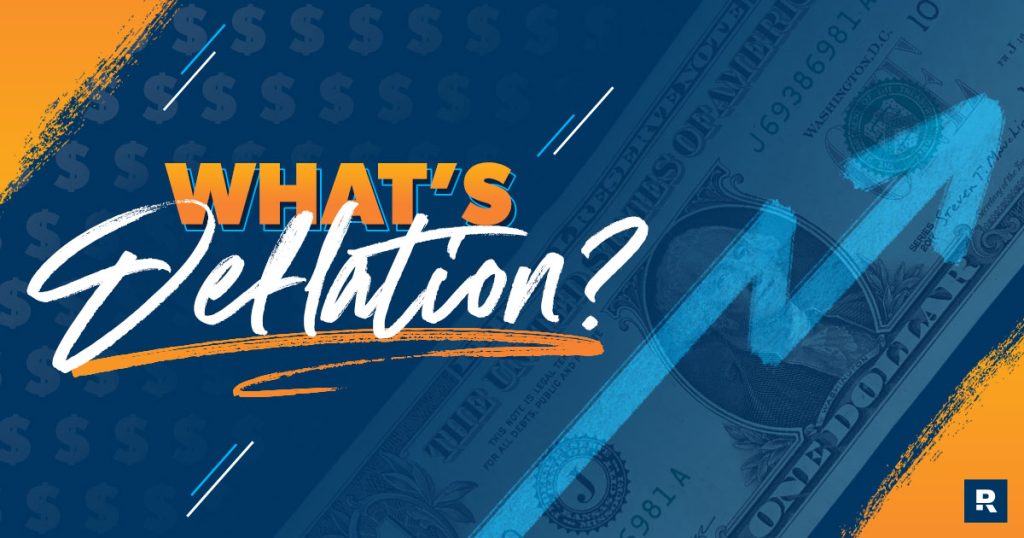What if we told you the prices on groceries, clothes and even houses were going to drop? You’d probably be thrilled! Lower prices? Heck yes. We’re big fans of you keeping more money in your pockets too—but not when the reason for it is deflation.
De—who? Deflation.
So what is deflation? Glad you asked. You’ve heard all about the hot topic of the year called inflation, but do you know about its sneaky sibling called deflation? Grab your book bags, kids, because we’re about to hit the economics class together.
What Is Deflation?
Deflation is when prices for goods and services go down over time and the rate of inflation drops under 0%. In plain words, that great big, deflation definition just means you can get more bang for your buck (aka purchasing power) when you head out to the store or shop online. When deflation happens, the value of the dollar goes up and stretches further. Sounds like a great thing, right?
Wrong.
Why Is Deflation Bad?
As nice as it sounds on paper—being able to buy more things because prices are cheap—deflation is actually no good. Why is deflation bad? Well, once you pull back the curtain here, you see a few things: Deflation can cause unemployment rates to spike, salary and hourly pay to drop, and big-time assets like homes to lose their value (we’ll dig into all that later). And sometimes, it can even spur on a recession. See? Like we said, no good.
So, how does deflation stack up compared to inflation? Hint: It’s exact opposite. Let’s take a look.
What Is Inflation?
Inflation is when the prices of goods and services go up. That means that the value of the dollar goes down and can’t go as far to cover prices.
Yeah, inflation is like the bad kid at school who just owns it, and deflation is like that one kid everyone thinks is good, but in reality, they’re up to shenanigans too—they’re just better at hiding it. We all knew that kid.
What Is Disinflation?
Disinflation happens when the inflation rate starts slowing down. Don’t get this one confused with deflation though (that’s easy to do). Disinflation just shows how much the inflation rate is going down from year to year (as long as it doesn’t drop past zero)—like marking a change of 5% one year to 3% the next. If the rate does fall past 0%, that’s deflation. And people wonder why kids fall asleep in economics class . . .
What Causes Deflation?
Deflation is caused when the need for goods and services goes down, which leads to an oversupply of products. There are a lot of different things that can play a role in making deflation happen, but most of the time, it all comes down to a pretty straightforward supply and demand problem.
If people aren’t spending as much money on goods and services, then the price of those items will go down to nudge more people to spend their money. Oh, this pair of jeans is so cheap—I just have to buy it! Again, it sounds good at first glance. But if deflation is happening, that means there’s some bad stuff going on under the surface. More than likely, people are bringing home less money and have less of it to spend on a whim. And because of that, folks are more likely to hoard their money because things look so unstable. They might even hold out for prices to drop even more before they make a purchase. This can really create a mess in the economy.
Are We Experiencing Deflation in the Economy Now?
Nope. Right now, we have the opposite issue on our hands—inflation. The Consumer Price Index shows that cost of goods and services has gone up 5.4% in the last year.1
Start budgeting with EveryDollar today!
And according to The State of Personal Finance study from Ramsey Solutions, 8 in 10 Americans say their money doesn’t go as far at the stores as it used to.
Still, what goes up has to come back down. And because of the inflation levels happening now, some economists say we could see deflation come our way in 2022. But the same people had said the 2020 recession was going to drag on—and it only lasted two months.2 So stay tuned for how that pans out. Just remember, it’s okay to be in the know, but don’t live your life being afraid about what could happen. That’s no way to live.
How to Calculate the Deflation Rate
First things first—the key to measuring deflation is the Consumer Price Index (CPI). It tracks how much the price of items and services changes over time (like how that soap and those apples you buy keep costing more). All right, now that we know what CPI is, we can crunch some numbers to figure out the rate of deflation. Sure, math can be a real drag—but the good news is, there’s a pretty simple formula to figure out the deflation rate. Stick with us here:
CPI of previous year – CPI of current year
_________________________________ = Deflation rate
CPI of previous year
So, let’s say the CPI from the previous year was 1.6% and the CPI for the current year is 0.8%. The deflation rate would be 0.5%. That big scary math problem wasn’t so awful after all.
How Does Deflation Impact the Economy and Your Money?
The effects of deflation aren’t pretty. Just take Japan for example—they’ve been dealing with deflation since the late 1980s. And because of it, Japan’s economy is stuck in a cycle that they just can’t seem to break free from—they rise up from deflation just to sink back down again.3 Unlike here in America right now, where we’re dealing with a 5.4% increase in prices, Japan’s cost of goods dropped to 0.1% in May—digging a deeper hole in their deflation deficit.4
How does something like that happen? Let’s break down how deflation impacts the whole economy:
Investments
For the most part, deflation isn’t very good news for stocks. And it makes sense why. Prices going down can really hurt a company’s bottom line. When people stop buying specific brands, that can lead to shareholders jumping ship from their investments—that’s no good.
And it’s not just stocks that take a beating. Let’s talk about the biggest purchase you’ll ever make—your home. Yep, you guessed it. The value on that big investment tanks during deflation too. Homes sell for close to dirt cheap during deflation because there is less demand (aka no one wants to buy them up).
Jobs
With fewer people spending their money, there’s a bigger supply of products for sale. That might sound like a great thing (no toilet paper shortage in sight here!), but a higher supply of items means there’s less need for manufacturing those things. That means there’s less need for production and less need for those jobs. Companies will likely stop hiring people, have no job growth to add to the market, and start layoffs.
Income
Thanks to the oversupply issue, a lot of businesses will lose money. And when the business is hurting, they might have to make tough choices to keep the lights on. The first thing they’ll do is probably cut wages and make raises a thing of the past. And if you’re making less money (even with prices of goods going down), you’re still going to hoard your cash and prepare for the worst-case scenario here. While that might be the best decision for you personally, that actually doesn’t help the economy as a whole. But at the end of the day, you have to do what’s best for you and your house.
How to Protect Yourself Against Deflation
Funny enough, the steps to protecting yourself against deflation aren’t that different from protecting yourself against inflation. The plan stays the same but looks different based on what’s going on in your world. Here’s how things shake out:
1. Stay calm.
This goes without saying, but you’d be surprised by how many times staying calm is the first thing to go out the window. So, step one—keep your cool.
2. Budget.
Having a budget is key to your success with money—deflation, inflation or pigs flying. You always need a budget telling your money where to go (yeah, even if you’re a millionaire). If you’ve got money, then you need to make it work for you. And a budget is the plan you need to make that happen.
If prices are lower because of deflation, well, then your money is going to go a lot further. Not a bad problem to have there. But remember, under deflation, people are usually making less money and not spending as much money. Because things look so rocky, they want to sit on all of their money. If you’re trying to spend as little as possible, you’re going to need a budget to help you keep those purse strings tight and see where you can cut back.
3. Save.
When deflation is happening, saving is what comes natural to most folks. Lucky for you, you’ve already been saving and it’s second nature at this point (we hope!). This is another one of those times when you can breathe easy because you had your emergency fund locked and loaded.
Need to find quick ways to save? Making small tweaks to how you spend money can add up to big savings. Look for ways to lower your grocery bill or save money on gas. Maybe it’s time to cancel some subscriptions, switch over to generic brands, or just bring your lunch to work. Remember, look at your budget to spot the places that need some fine-tuning to make the savings happen.
And don’t forget—deflation means the Federal Reserve will likely raise interest rates. That means it’s a good time to hurry up and get out of debt, plus a great time to let your savings grow thanks to the little extra bump in interest.
4. Invest.
The best way to protect yourself against deflation (or inflation) is to invest your money in a diverse way—you know, don’t have all your eggs in one basket. And the sooner you can invest, the better. But remember, if you still have debt (other than your mortgage) and don’t have an emergency fund fully stacked, you need to take care of both of those things first. The sooner that’s squared away, the sooner you can tackle investing and watch those investments grow.
But don’t just wing it and hope things work out for you. Talk with an investing pro to make sure you’re in a good place—deflation or not. A SmartVestor pro will walk you through the process and guide you toward the best plan for your money.
Read the full article here












